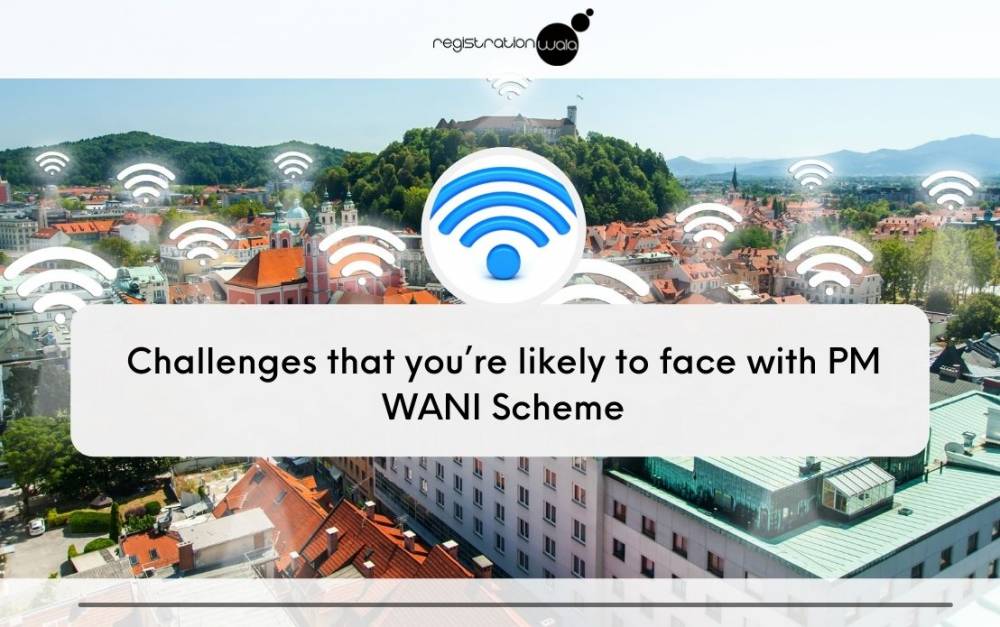Challenges that you’re likely to face with PM WANI Scheme
- May 13, 2022
- Registrationwala

- Home
- /
- Knowledge Base
- /
- Telecom
- /
- PM WANI Registration
- /
- Challenges that you’re likely to face with PM WANI Scheme
Challenges that you’re likely to face with PM WANI Scheme
Let’s discuss.
What is PM WANI Scheme?
PM WANI (Wi-Fi Access Network) scheme is a government-run drive to increase internet accessibility by introducing Wi-Fi connectivity across India. The scheme works as per a WANI framework containing the following components:
- A public Data Office: It establishes, operates and maintains WANI compliant Wi-Fi access points to deliver broadband services to subscribers
- Public Data Office Aggregator: It’s an aggregator of public data offices that performs functions pertaining to accounting and authorization.
- App Provider: It develops app for users to register with so that they can discover WANI compliant Wi-Fi hotspots in their proximity.
- Central Registry: it will maintain a record of all the Public Data Offices, Public Data Office Aggregators and App providers.
Here is how the government is proposing the scheme would work.
- Those who want to become a Public Data office (PDO) will purchase net work services from a TSP
- Afterwards, the PDO will register itself with a Public Data office aggregator via the App
- When the users will come within the Wi-Fi interfaces vicinity, the app will alert them of the nearest PDO. They then proceed to select it who will provide them internet access once the users deposit the payment and the PDO authenticates the users.
The current digital divide that exists
If you go by the data we received on June 2020, the number of internet subscribers have increased by 0.79% to 749.077 million. However, even when the penetration of internet connectivity is rising, there is a matter of digital divide. It exists due to gender gap and the gap that exists between the number of internet users in urban and rural areas.
When seen through data, we observe that the number of rural internet subscribers are almost 1/3rd of urban internet users.
When you consider the another reason of digital divide – the gender gap, less than 40 percent women use internet services in India. It further necessitates a closer look at the discrepancy that exist in both urban and rural regions.
Security concerns of the Scheme
Regardless of how fruitful the government deems an open Wi-Fi, once can’t deny its vulnerabilities:
- It’s susceptible to hacks and breaches
- The architecture implemented to establish a WANI network should still include insufficient security standards, no matter how robust the government officials try to make it.
- There is a severe lack of data protection regulation. It’s mostly due to government’s inclination towards making everything more transparent. However, the personal data of a user is still at stake.
- As per the PM WANI rules, a PDOA can store personal data for the user for 1 year. This rule might contravene the Right to be Forgotten. it might not be an absolute right yet. However, the personal Data protection bill of 2019 have states that this right should be fundamental.
- State is stepping back from providing internet services. While it had made room for the evolving private sector to step in, it has also paved the way of increased internet prices. Therefore, it stands to reason that WANI based internet services would prove costly for the users.
Conclusion
The PM WANI scheme has opened the gate to more internet accessibility. But is more better if the division between those who can access internet and those who can’t still exist? What about the issues stemming from security issues? Do we just ignore them?
Of course we can’t. However, our recommendation to everyone is to remain patient. This scheme is not even an year old and therefore, we should remain patient and see how it morphs into something that more aligns with India’s goal of Internet for all.
- 4624 views
